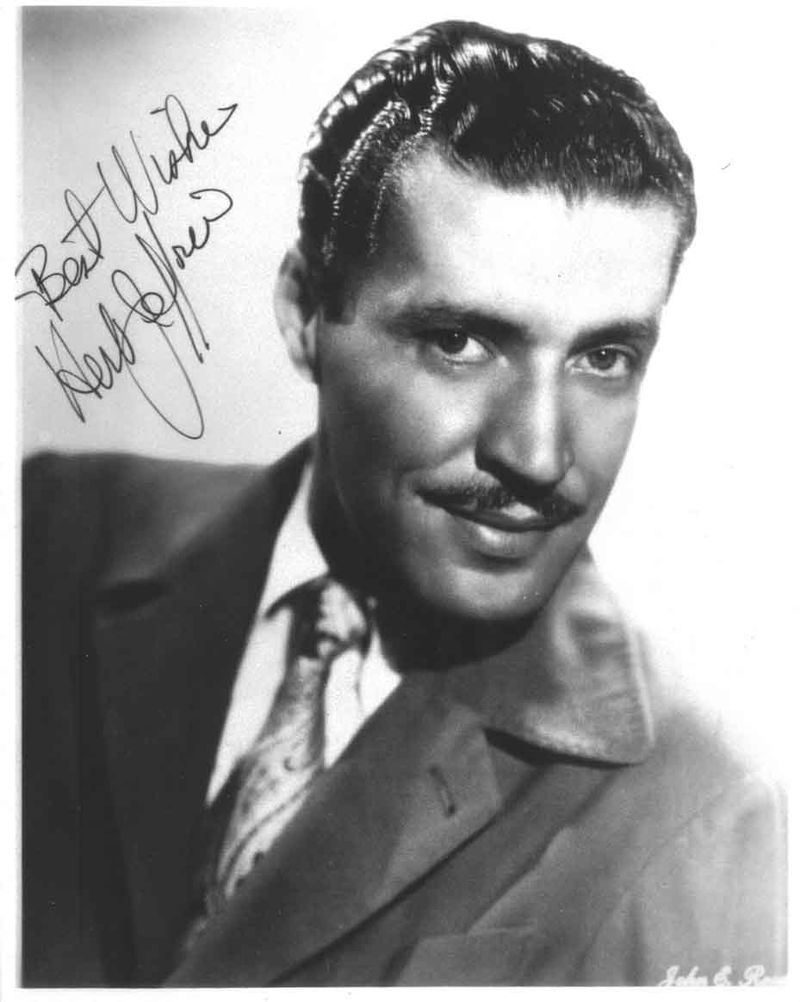Herb Jeffries
Background information
Birth name Umberto Alexander Valentino (alt. Umberto Alejandro Balentino or Ballentino
Also known as Herbert Jeffrey the Bronze Buckaroo The Sepia Singing Cowboy
Born September 24, 1913
Detroit, Michigan, US
Died May 25, 2014 (aged 100)
West Hills, Los Angeles, California, US
Genres Jazz, popular
Occupation(s) Singer, actor
Herb Jeffries (born Umberto Alexander Valentino; September 24, 1913 – May 25, 2014) was an American actor of film and television and popular music and jazz singer-songwriter, known of his baritone voice. He was of African descent and Hollywood’s first singing black cowboy.
In the 1940s and 1950s Jeffries recorded for a number of labels, including RCA Victor, Exclusive, Coral, Decca, Bethlehem, Columbia, Mercury and Trend. His album Jamaica, recorded by RKO, is a concept album of self-composed calypso songs.
He starred in several low-budget “race” Western feature films aimed at black audiences, Harlem on the Prairie (1937), Two-Gun Man from Harlem (1938), Rhythm Rodeo (1938), The Bronze Buckaroo (1939) and Harlem Rides the Range (1939). He also acted in several other films and television shows. During his acting career he was usually billed as Herbert Jeffrey (sometimes “Herbert Jeffries” or “Herbert Jeffries, Sensational Singing Cowboy”.
Jeffries was born Umberto Alexander Valentino in Detroit to a white Irish mother who ran a rooming house. His father, whom he never knew, was of mixed Sicilian, French, Italian and Moorish roots. He also claimed that his paternal great-grandmother was an Ethiopian with the surname of Carey.
Firm evidence of Jeffries’s race and age is hard to come by, but census documents from 1920 described him as mulatto and listed his father as a black man named Howard Jeffrey. Jeffries himself, late in life, said that Howard Jeffrey was his stepfather, and his biological father was Domenico Balentino, a Sicilian who died in World War I.
Jeffries once described himself in an interview as “three-eighths Negro”, claiming pride in an African-American heritage during a period when many light-skinned black performers were attempting “to pass” as all-white in an effort to broaden their commercial appeal. In marked contrast, Jeffries used make-up to darken his skin in order to pursue a career in jazz and to be seen as employable by the leading all-black musical ensembles of the day.
Much later in his career, Jeffries identified as white for economic or highly personal reasons. Jet reported that Jeffries identified as White and stated his “real” name as “Herbert Jeffrey Ball” on an application in order to marry Tempest Storm in 1959. Jeffries told the reporter for Jet:
From Detroit, at the urging of Louis Armstrong, Jeffries moved to Chicago where he performed in various clubs. One of his first gigs was in a club allegedly owned by Al Capone. Jeffries began his career working with Erskine Tate and his Vendome Orchestra. Tate signed the 19-year-old Jeffries to a contract with his Orchestra at the Savoy Ballroom in Chicago. His break came during the 1933 Chicago World’s Fair A Century of Progress International Exposition singing with the Earl Hines Orchestra on Hines’ national broadcasts live from the Grand Terrace Cafe. His first recordings were with Hines in 1934, including “Just to be in Carolina”. By 1940, he was singing with the Duke Ellington Orchestra and then recorded with him from 1940 to 1942. His 1940 recording of “Flamingo” with Ellington, released in 1941, sold more than 14 million copies in its day. His name had been Herbert Jeffrey, but the credits on the record mistakenly called him Jeffries, so he renamed himself to match the typo. “Flamingo” was later covered by a white singer, the popular vocalist Tony Martin. During his time with the Duke Ellington Orchestra as a lead vocalist, Jeffries proved his talent as a mature singer, demonstrating his wide vocal range in such songs as “I Don’t Know What Kind of Blues I’ve Got,” “The Brownskin Gal,” and “Jump for Joy” (all 1941). The 1944 single “My Little Brown Book” by Ellington and his Famous Orchestra, on which Jeffries provided vocals, reached No. 4 on Billboard R&B chart. Later on, Jeffries was replaced in the Ellington’s band by Al Hibbler.
In his teens, Jeffries had developed a fine voice, initially singing in higher registers.[16] He started out his singing career as a lyrical tenor, but, on the advice of Duke Ellington’s longtime music arranger, Billy Strayhorn, he lowered his range to mimic the vocal stylings of crooner Bing Crosby. Jeffries became a “silken, lusty baritone,” according to music critic Jonny Whiteside.
In 1945, Jeffries had a hit on the Billboard R&B chart with “Left A Good Deal In Mobile” (No. 2), on which he was accompanied by pianist Joe Liggins and his band Honeydrippers. Then, he moved to Europe and performed there for many years, including at nightclubs he owned. He was back in America by the 1950s, recording jazz records again, including 1957 collection of ballads, Say It Isn’t So.
In 1995, at age 81, he recorded The Bronze Buckaroo (Rides Again), a Nashville album of songs on the Warner Western label.
Selected filmography
Harlem on the Prairie (1937)
Two-Gun Man from Harlem (1938)
Harlem Rides the Range (1939)
The Bronze Buckaroo (1939)
Calypso Joe (1957)
Chrome and Hot Leather (1971)
Portrait of a Hitman (1977)
Discography
Sidney Bechet: 1940–1941 (Classics)
Earl Hines: 1932–1934 (Classics)
Duke Ellington:The Blanton–Webster Band (RCA , 1940–42)
Michael Martin Murphey: Sagebrush Symphony
Jamaica (RKO) all songs composed by Jeffries
Passion (Brunswick) Coral singles compiled on 12″ LP
Say it Isn’t So (Bethlehem) with the Russ Garcia Orchestra
Herb Jeffries (Harmony) Columbia singles LP
Magenta Moods (Mercury 10″) LP transfer of Exclusive label album
Herb Jeffries Sings (Mercury 10″) more Exclusive singles with the Buddy Baker Orchestra
Herb Jeffries and His Orchestra (Mercury 10″) Exclusive label singles
Songs by Herb Jeffries (Mercury 10″) Exclusive label singles
I Remember the Bing (Dobre)
Play and Sing the Duke (Dobre)
The King and Me (Dobre)

